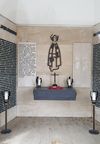

|
|
|
|
|
|
central wall, row 13

Limburg 1940-1945,
Main Menu
The fallen resistance people in Limburg
Karel Joseph Diederen
∗ 10-10-1917 Hoensbroek † 02-03-1943 KZ Sachsenhausen, Oranienburg (25)
- Underground Press - Initial resistance - Group Smit - Hoensbroek -
- heemkundehoensbroek.nl
- Archief Oorlogsgravenstichting (@ Nationaal archief),
Dossier Karel Joseph Diederen • #2 • #9 • #10 - Dr. F. Cammaert, Het Verborgen Front – Geschiedenis van de georganiseerde illegaliteit in de provincie Limburg tijdens de Tweede Wereldoorlog. Doctorale scriptie 1994, Groningen
2. De eerste militair-civiele verzetsformaties - gedenkorte.net Sachsenhausen (Standort d. ersten Krematoriums)
- Oorlogsmonument Hoensbroek
- Erelijst 1940-1945
- Oorlogsgravenstichting.nl
- http://www.heemkundehoensbroek.nl/slachtoffers_oorlogsgeweld.html#Diederen,%20Karel%20Joseph
In his younger years he was active in the youth movement. When he was drafted into military service, he was a casual laborer. From September 2, 1937 with the 3rd Mounted Field Artillery Regiment, where he rose to the rank of wachtmeester (~ sergeant). After the surrender of the Dutch army in May 1940, he was demobilized. Became a member of the Smit Group, which initially attracted mostly ex-soldiers. After the war, his father said he intended to go to England. According to the entry register at Maastricht prison, he was a bread deliverer at the time. [1])
In his file at the OGS is also bread deliveryman, namely at the wholesale bakery ODB (Ons Dagelijks Brood, = Our Daily Bread) in Heerlen. [2#2]
Arrested on February 13, 1942 for belonging to the Smit group, but no individual acts of resistance are known to have been committed by him. [2#2]
Then via Maastricht and Amersfoort to Oranienburg, where he died according to death certificate No. 1o23/1943 of the registry office dated 25 March 1943 on 2 March 1943 at 5 hours 30 minutes. [2#12]
According to Cammaert, he died on March 6, 1943.[3]
Such differences in reporting the date of death in a concentration camp are common. For example, because someone was still seen after the camp administration had already declared him/her dead. Sometimes it’s not even clear in which concentration camp someone died, especially if it was towards the end of the war.
In the concentration camps, a crematorium was usually in use. Then, of course, there was also no individual grave, as in this case: No grave site known. [2#9][4]
His name is on the Hoensbroek war memorial [5].
According to erelijst.nl he was a miner:
Karel Joseph Diederen is listed in the Erelijst 1940-1945 (Honor Roll of the Dutch Parliament). [6]
Footnotes
